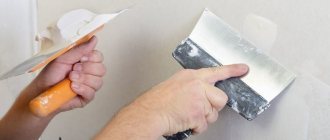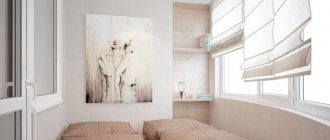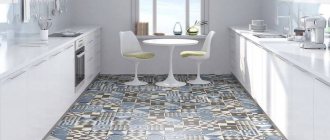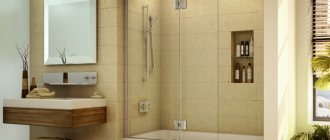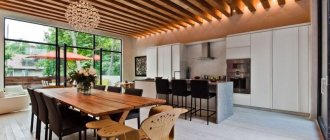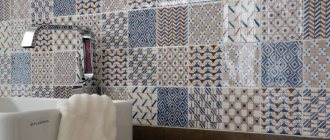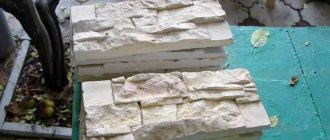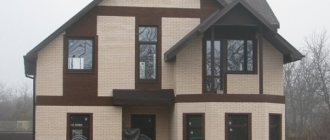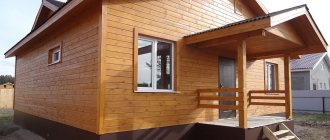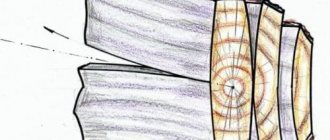What is fiberboard?
The word “hardboard” is often used together with the word fiberboard. In some cases, it seems that hardboard is some kind of separate type of wood boards. In fact, from a technical point of view, hardboard is a “folk” term that is most often applied to solid fiberboard. A difficult fate befell the concept of MDF, which on the one hand is very similar to fiberboard in production technology, but at the same time in the mass consciousness it often appears as a completely different material. MDF is a transliteration of the English designation MDF (Medium Density Fiberboard), in Russian it is called medium density fiberboard.
Fiberboard is produced by thermal pressing of wood fibers. In some cases, raw materials are dried for production. In fact, the raw material is waste from the wood processing industry. The binding components are various synthetic resins; the composition also includes paraffins, antiseptics, fireproofing agents and other additives. The production method using resins is called “dry”; if such additives are absent, then the production method is considered “wet”. To obtain “dry” material, the raw material is crushed many times, without adding water to the composition. The sheets are more durable and elastic.
Fiberboards can be of different thicknesses and densities
Sheet fiberboard is characterized by high density and strength, and has a relatively low price. Thin sheets bend well, which allows them to be used for covering curved surfaces. Fiberboard is used in construction, as cladding in frame house construction, for leveling floors and walls. Partitions in railway passenger cars are also made from this material.
Low-density fiberboard is used as a soundproofing material. The chaotic arrangement of wood fibers causes sounds to “get stuck” in the material. This is the most inexpensive and easiest to install type of soundproofing materials. There are more effective ones, but you still need to look for cheaper ones.
Some types of fibreboards can be used as finishing materials - for finishing walls in rooms with normal humidity. For these purposes, fiberboard is used, one of the sides of the sheet is painted, covered with a decorative film, or laminated.
These are options for decorative finishing
Another area of application for fiberboard is furniture production. Usually this material is used as an auxiliary material - they make the back wall of cabinet furniture, hem the bottoms of armchairs and chairs, the bottoms of drawers, etc. In general, the scope is wide. There is essentially only one drawback - without hydrophobic additives, the material behaves poorly at high humidity. It swells, increasing in size. In this case, the sheet material “goes in waves.” When it dries, it remains deformed. So in unheated or damp rooms it is possible to use only certain brands of fiberboard.
Ask a Question
Didn't find the answer to your question about the choice or use of finishing materials, building materials and household goods? Ask us on the forum and we will send you an answer via . We work with tens of thousands of products and are always ready to share our accumulated experience.
Ask a Question
Moscow, Moscow region, Zelenograd, Podolsk, Lyubertsy, Mytishchi, Kolomna, Elektrostal, Khimki, Balashikha, Korolev, Serpukhov, Odintsovo, Orekhovo-Zuevo, Noginsk, Sergiev Posad, Shchelkovo, Zheleznodorozhny, Zhukovsky, Krasnogorsk, Klin, Ramenskoye, Voskresensk, VladimirProduction technology
The starting materials for the production of fiberboard are waste from the wood processing industry: wood chips, sawdust, firewood (woody parts of the stems of spinning plants). The raw materials are washed, foreign inclusions are removed from them, and then dried. The dried material is crushed in special machines (defibrators and refiners) into small particles - fibers. The degree of grinding can be from coarse to fine. Further, the process differs for different production methods.
Feedstock for fiberboard production
Pressing takes place under high pressure - 3-5 MPa and high temperature - above 300 °C. Due to this, the bonding and compaction of the material occurs. Before pressing, additional components are added to the source material to change the properties of the material - binders (synthetic resins), water repellents, fire retardants, etc.
Forming methods
There are two ways to produce fiberboard - wet and dry pressing. The “wet” method is more environmentally friendly. When wet pressing, fewer binders are used (sometimes without synthetic additives at all), but the material is more expensive, since the process is more energy-intensive. It takes up to 15 minutes to dry one sheet, which limits the productivity of the presses and, therefore, increases the price of the material. With this method, the necessary additives and water are added to the crushed material. The liquid substance enters the dispenser, which spreads it in an even layer on the belt. For faster water removal, the tape has a mesh structure. After passing through the press, the back side of such fiberboard has an imprint of this fine mesh.
When wet pressing, some types of fiberboard can be made without adding any foreign binder. Under pressure and at high temperatures, lignin (a substance that characterizes the woody walls of plant cells) is released from wood fibers. It is a natural binder. Lignin is found in significant quantities in coniferous wood. But not all types of fiberboard need a natural binder. In this case, from 4 to 7% of a synthetic binder is added.
The type of molding can be easily distinguished by the back side of the plate
When dry pressing, synthetic resins are usually added to the mass, which bind the fibers. It is this method that makes it possible to obtain fiberboard of large thickness - up to 12-15 mm; some factories can produce pits up to 40 mm thick. Compaction and pressing of dry mass takes much less time - 3-5 minutes depending on the class and thickness. The productivity of the press increases significantly. In addition, fewer additives are added to the dry mass - they are not washed out with water. All this leads to a reduction in the cost of the material. But cheap binders contain formaldehyde, and its content must be controlled, since in large quantities it is harmful to health.
For the production of furniture and interior finishing work, material with a formaldehyde emission class of E0.5 or E1 must be used. This is usually wet-pressed fiberboard. You can distinguish fiberboard made using the wet method by the mesh imprint on the back of the sheet (see photo above).
Final processes
During high-temperature pressing, particles stick together. The time spent under the press is not always enough, so the already formed sheets are transferred to a special chamber, where the “ripening” of the material occurs at high temperatures. The fiberboards are kept here for several hours. During this time, the fibers are sintered and glued together, the material becomes homogeneous and durable.
Fiberboards have different thicknesses
The slabs leave the chamber with almost zero humidity and begin to actively absorb moisture from the air. As a result of this process, the edges of the sheets swell. To avoid this drawback, the material is transferred to another chamber, where it is brought to normal humidity. And only after this, the fiberboard sheet can be sold or used on other machines - for painting, laminating.
What's good is that fiberboard technology is flexible. The press can have any shape, which allows you to make not only sheet material, but also shaped products. For example, baseboards or furniture fronts.
Array
| Advantages: | Flaws: |
| + Environmental friendliness | - High price |
| + Aesthetics | — Low protection against moisture |
| + Saturates the air with a pleasant aroma | — Vulnerability to temperature changes |
| — Heavy weight | |
| — Need for special care |
Solid oak texture
Types and classes
The main classification of fiberboard is by purpose and density. According to their intended purpose, fibreboards are of general and special types. Special - these are with some special properties. Three main groups can be distinguished:
- Moisture resistant (bituminized). When preparing the mixture, bitumen is added to it, which improves resistance to moisture.
- Difficult to burn. Fire retardants are added to the starting material, which reduce the flammability of the finished material. Thin sheets bend well, thick sheets have high rigidity, so the material can be used for different purposes.
- Finishing - with one side refined. The front side of the fiberboard can be painted, glued with a polymer film that imitates various materials: wood, stone, brick, tile, etc.
Finishing types of fiberboard - with one side treated - are also classified as special-purpose materials. There are a lot of subspecies and they can be called differently:
- Fibreboard with a lined or painted surface, smooth on the back (produced by dry pressing). In colloquial speech, such material is usually called “hardboard”. This is usually a medium density material.
- The same thing, but with a non-smooth back surface, is called “masonite” (wet pressing). Sheathing a dacha with fiberboard is a common solution
- If the front side of the material is glued with film - laminated - this material is called laminated fiberboard, sometimes the abbreviation LDVP is found.
General purpose fiberboard is also called construction fiberboard. This class can include materials of both dry (with two smooth surfaces) and wet production methods.
Price or quality?
Typically, the main criterion when choosing general-purpose fiberboard is low price. If you use it to cover the frame, a lot of material is required, so you want to save money. But you shouldn't chase cheapness.
The quality of fiberboard is determined by the absence of foreign inclusions or delamination
Cheaper fiberboard sheets are made with more formaldehyde. This substance in large quantities contributes to the development of cancer. To make your home safe, you should not use material with an emission class higher than E1 for interior cladding. Materials with class E1 are absolutely safe. They emit as much formaldehyde as natural wood.
Properties
The properties and reliability of hardboard depend on the surface treatment, production process and types of material. Durability in various conditions is determined by the composition of the products. For example, the following additional components are used:
- Binding filler. This is an artificial type resin. Particular care must be taken when handling materials that contain phenol-formaldehyde.
- Polymer components. Such additives are used to increase mechanical strength. For example, they use pectol.
- Hydrophobes. These are substances that have a water-repellent effect. For example, stearin, paravin, cerisin, and rosin are used.
- Antiseptics. These products prevent rotting of wood and the development of mold on its surface.
- Fire retardants. These are products that are resistant to fire. Thanks to this, the material can fade out on its own.
The main component is still wood. The amount of filler and additives is no more than 7%. In especially hard sheets - approximately 1.3%.
Density, weight, thickness of sheets
The technology for the production of wood-fiber boards allows them to be made in different densities. Depending on the density, they have different technical characteristics and areas of application. There are the following types of fiberboard:
- Low density. They are also called soft, they can be designated using the attached letter “M” - DVP-M. Quite loose material with a density of 200-350 kg/m³. Sheet thickness can be 8, 12, 16, 25 mm. If desired, you can find up to 40 mm. They are usually used for sound insulation or as finishing/cladding in areas not subject to load. Low-density fiberboard has a loose structure, used as insulation and sound insulation
- Medium density - up to 850 kg/m³, sheet thickness can be 8, 12, 16, 25 mm. They are also classified as soft.
- Semi-solid - from 860 to 900 kg/m³, sheet thickness 6, 8, 12 mm.
- Solid (fibreboard T) - 950 kg/m³, sheet thickness 2.5, 3.2, 4.5 and 6 mm.
- Super-hard (Fiberboard-ST) - 960-1000 kg/m³, can be 2.5, 3.2, 4.5 and 6 mm thick.
Hard and super-hard grades are used where resistance to mechanical stress is important. In domestic construction and finishing of houses/apartments, fiberboard-T is placed on the floor, and walls can be sheathed with it.
Types of solid slabs
With all this, general-purpose solid fiberboards come in several types - with different front and back sides. According to GOST, solid fiberboards are marked as follows:
- T - solid slabs with an untreated front surface. Often also called “technical” fiberboard. Used for work in which appearance is not important.
- T-P - solid slabs with a tinted front layer. This is the so-called hardboard. Used in the furniture industry for back walls in cabinets, tables, etc. The choice of colors is wide
- T-S - solid slabs with a front layer of fine wood pulp. One side of the sheet has the same color, but is smooth, as if varnished. Can be used for cladding frame buildings from the inside. Requires minimal finishing work. You can paste wallpaper onto such a rhinestone surface, but removing it will be very inconvenient. But the putty does not fit well on a smoothed surface - it rolls off.
- T-SP - solid slabs with a tinted front layer of finely ground wood pulp. Can be used as a finishing material.
Brands of hard fiberboard can be of two classes - A and B. They are distinguished by quality. As you can see, even in the same class there are different materials. With the same (or almost identical) technical characteristics, they have different areas of application.
Subtypes of super-hard fiber boards
Super-hard wood-fiber boards are rarely used in household construction and repairs - the price is too high, and high density and rigidity may not be in demand. Sometimes being too firm can be uncomfortable.
According to the standard, there are two types of such material:
- ST
is a “construction” brand, not very attractive in appearance; - ST-S
– with a smooth face layer - finely ground wood pulp is compacted to a very smooth state. Dense and smooth slabs
There are practically no laminated or decorative types - a material that is too heavy and hard for finishing is also not needed.
Names depending on density
Fiberboards also have different names depending on their density. Usually this is a tracing paper (transliteration) of English/international names. Although the same name often means a different material in other countries.
- LDF - from the English low density fiberboard - LDF. Translated - low-density fiberboard. In fact, this is the name given to a medium-density material that simply has characteristics at the lower boundary of the zone. Has nothing to do with soft wood boards. Characteristics of MDF
- MDF - from the English medium density fiberboard - MDF. In translation - medium density fibreboard. If we talk about standards, then this material meets the GOST definitions of medium-density fiberboard.
- HDF - high density fiberboard - HDF. According to the characteristics, the grade Fiberboard-T (solid) can be assigned. HDF boards are usually thin and are used for routing patterns.
As you can see, there is no clear distinction. Adding to the confusion is the incorrect use of names. In general, each time it is necessary to clarify what exactly the speaker means by this or that term.
Comparison of materials
To determine the difference between the slabs, it is necessary to consider a number of factors:
- Environmental friendliness. There is an opinion that only wood-fiber products can be used for furniture production, since they are environmentally friendly. In fact, all varieties produced in large quantities contain a certain percentage of binder resins that are toxic, but their concentration does not exceed the norm.
- Wear resistance. Determining the most durable material is not always easy, since all varieties tolerate mechanical loads well, but are deformed when subjected to point impact.
- Resistance to humidity. If we compare MDF and laminated chipboard in this parameter, the first option will be the undisputed favorite. Furniture for bathrooms and shower rooms is made from medium-density boards. But properly treated laminated chipboard parts can also withstand fluctuations in humidity.
The quality of MDF panels is certainly higher, but in furniture sets these characteristics are not always in demand, especially when it comes to dry heated rooms, so sales of laminated chipboard and MDF are at the same level
A negative attitude towards products made from chipboard arises due to the fact that low-quality products are present in large volumes on the furniture market. It is mainly produced in private workshops, where, to reduce the cost of production, low-density slabs are used and the fittings are distributed without taking into account technology.
Dimensions
It makes sense to talk about sizes only in relation to standard sheets or slabs. As mentioned earlier, the thickness of fiberboard sheets can be from 2 to 40 mm. The remaining sizes are determined by the standards:
- width 1220 mm and 1700 mm;
- height 2140 mm, 2440 mm, 2745 mm.
Dimensions are determined by standards
Please note that in any production you can find non-format sheets. After molding in the press, they are trimmed, and sometimes, due to malfunctions of the equipment (which forms the carpet on the belt), the edges have to be trimmed more. Because of this, narrower or shorter sheets are obtained. If you don't care about the standard size, you can always buy these. In quality they are unlikely to differ in any way, but in price they will be much lower.
Storage Features
Hardboard sheets are intended for indoor use, so it cannot be stored outdoors. With prolonged exposure to moisture and ultraviolet radiation, it can be destroyed.
In warehouses, products are stacked according to size and grade. The height of the stacks should not exceed 3.5 m. This will avoid excessive pressure on the material and changes in its strength properties.
During handling and storage, manufacturers must ensure that there is no mechanical impact to avoid damage to the surface of the sheets.
Storing slabs in warehouses.
Modern use of some species
If we talk not about construction, but about finishing work, then the name “MDF” - a medium-density fibrous material - has begun to appear more and more often in this area. Interior doors are made from laminated sheet MDF. A frame made of wooden planks is sheathed with this material, resulting in budget products that look very good. Soundproofing characteristics depend on the type of frame filling, and the durability of the product itself depends on the quality of lamination and the rigidity of the film.
Any relief can be formed from wood fiber mass
Production technology makes it possible to create not only sheet wood-fiber products. Theoretically, the shape of the press can be any. Therefore, various types of moldings began to be made from MDF - platbands for finishing the same door frame, baseboards and other similar products. They can be matched to the color of the doors and similar in shape.
Such smooth lines can only be made using wood or MDF
The facades of cabinet furniture began to be made from MDF. For example, kitchen ones. Moreover, if furniture made from chipboard has a linear structure, curved, smooth, rounded shapes are formed from ground wood fibers. All this allows us to create greater species diversity. Using the same technology, MDF wall panels are made. These are not only even, smooth sheets, but also with patterns of different types/types.
Tough fibrous materials
HDF, a high-density material, is used in some areas. In particular, due to its rigidity, it is convenient to work with when forming openwork. Using laser cutters, slotted openwork is formed on thin laminated or painted HDF boards. Various decorative elements are made from openwork slabs, in particular, screens for radiators.
Perforated HDF is good for decoration
Some types of finishing materials are formed from HDF. The plate is covered with a layer of film or painted. The surface can be smoothly painted, imitate wood, stone surface, etc. If the material is molded in the form of strips with locks, the same laminate is obtained. If the material is made in the form of sheets, they can be used to cover walls, ceilings, and be used to decorate the work area in the kitchen - a kitchen apron.
Surely there are other areas of application of fiberboard of different densities. And, most likely, there will be other uses. The technology is flexible and allows the production of materials with different properties.
Products in category
MDF wall panel Kronospan, White crystal, 2600x200x7 mm
99.51 rub.
| MDF wall panel Kronospan, Birch, 2600x200x7 mm 99.51 rub. | MDF wall panel Kronospan, Beech, 2600x200x7 mm 99.51 rub. | MDF wall panel Kronospan, Wenge Cairo, 2600x200x7 mm 99.51 rub. | MDF wall panel Kronospan, Cherry, 2600x200x7 mm 99.51 rub. |
Where is it used?
Fiberboard sheets are used in various fields.
Construction
Here this material is used as sound and heat insulation, surface leveling, and decorative coating. The following areas are particularly highlighted:
- For wall decoration. Fiberboard is used to level the wall surface under the finishing coating. The slabs smooth out all the unevenness of brick or block masonry and wooden frames. This surface can then be covered with wallpaper or decorated by painting and whitewashing.
- For finishing floors. Leveling rough wooden flooring or concrete screed is done with sheets of 5-8 mm thick hard type. You can safely lay parquet, linoleum or laminate on top of fiberboard. At the same time, the slabs act as sound insulation.
- For ceilings. Using fiberboard, wooden ceilings are leveled, and after installation, whitewashing can be done without plastering. This material has also gained popularity in the manufacture of suspended ceilings.
We recommend: Mineral wool insulation - dimensions, which is better, characteristics. What and how to insulate using mineral wool
Manufacturing of furniture and doors
In cabinet furniture (cabinets, bedside tables), the back walls are most often made of fiberboard, which is facilitated by low cost, sufficient strength and durability. Sheets are used to make the bottoms of drawers, armchairs, and sofas.
Almost everyone is familiar with panel doors, which are used as interior and entrance doors. The wooden frame of such products is covered with fiberboard sheets. The surface is painted or varnished. Decorative (laminated) options do not require coating at all.
Manufacturing of containers
Boxes of different sizes are made by covering a wooden frame with fiberboard sheets. Such containers are highly durable and inexpensive.
Fiberboard is used for finishing the interiors of various vehicles.
In addition to using regular fiberboard, you should remember that special products are also produced that can be safely used in conditions of high moisture, in sports and medical institutions, increased fire safety requirements, etc.
Chipboard
The abbreviation stands for “particle board”. This material is the result of pressing a raw material mass consisting of shavings and sawdust mixed with resin (usually formaldehyde). Moreover, in the process of squeezing the mixture, it is subjected to significant thermal effects.
Features of the material
Such slabs are thicker than fiberboard (up to 50 mm), which allows them to withstand heavy mechanical loads. In everyday life, they are most often used when installing “dry” screeds, reinforcing vertically oriented surfaces (with the obligatory “backing”), and as a basis in various structures. Cheap furniture is made from them, partitions, racks, canopies, fences and the like are arranged.
The main drawback is the somewhat “loose” structure. This makes it difficult to fasten the slabs to each other or to other structural elements. The self-tapping screw does not “sit” firmly in the material. That is why it is not recommended to use it in the manufacture of temporary prefabricated/collapsible structures. Frequent dismantling/installation leads to damage to the areas where the fasteners are placed, as the base in these places begins to crumble.
In addition, such boards require systematic surface treatment (for example, varnish), as they absorb moisture well. They are not recommended for use outside buildings, in the open air or in damp areas.
The “rigidity” of the samples does not allow, if necessary, to achieve even slight bending. Any attempt will lead to the formation of a crack, which somewhat limits the use of chipboard.
When purchasing slabs, you should inquire about their structure. The best samples are three-layer ones.
Application area
The scope of product use is quite wide:
- Manufacturing of furniture backs and drawer bottoms. Colored fragments of decorative variations allow you to hide areas of walls, slides, living rooms or cabinets for the kitchen and bathroom.
- As a facing material. The sheets are mounted on the walls and ceiling, creating a flat surface for further work. Keep in mind that gluing tiles or wallpaper to such a base is quite difficult; preparatory measures are taken for this. The parts are also suitable for laying on the floor as a substrate. But if necessary, hardboard can be used independently as a finishing coating.
- Fitting of economy class interior doors. The slab is placed on a lightweight cellular base, which ensures low weight of the structure.
- Finishing the interior of cars, wagons, as well as creating protective packaging and linings for transporting various items.
Compared to fiberboard, hardboard has a narrower scope of use, related to hard boards.
Which material is better?
This question is somewhat incorrect, since in essence it is the same as comparing warm with soft. Each type of material is best used for its own purposes.
Chipboard is perfect for:
- making interior partitions;
- insulation of walls from the inside;
- arrangement of the subfloor;
- furniture production.
In the latter case, hardboard will also come in handy, because the back walls of cabinets and all kinds of drawers are made of this material. All kinds of wall surfaces are finished with fiberboards, especially in country houses, on balconies and in garages, because they are much less afraid of moisture than thick chipboards. Hardboard is also suitable as a substrate for the floor or an insulating layer on the ceiling, and real construction virtuosos can easily turn its sheets into an elegant interior arch or a patterned door.
Many materials are used in the repair and construction of residential buildings, but among them there are those that have simply covered themselves with unfading glory. Take, for example, fiberboard. What it is?
The name stands for "fibreboard". This is a sheet material, the production of which occurs by pressing wood chips with the addition of various types of binding components.
As a rule, synthetic polymer resins are used in the latter form. In addition, they include various substances that impart hydrophobic properties to the finished material.
The cheapest (and therefore most often used) are ceresin and paraffin. Antiseptic additives are often added to the composition. Because of them, mold practically does not grow on fiberboard. What it is? Most often, phenols act as such an antiseptic additive, which successfully prevent the development of fungi and destroy their spores.
They are produced in two ways: dry and wet. However, intermediate methods have recently appeared: wet-dry and semi-dry.
The cheapest is the dry method, when fiberboard (what it is, we have already said) is formed from wood chips under normal conditions and without wetting it with water. The plate is pressed at high temperature and pressure.
The resulting material is characterized by low cost, significant porosity and lightness. Its humidity is only 6-8%.
The wet method consists of the same steps, but wood chips are sent for pressing, being moistened with water. After leaving the bale chamber, the material is cut into individual sheets and sent to the dryer. Such fiberboard panels have a humidity level of already within 70%. That is why they are heavier, but more durable.
The semi-dry method is similar to the first method described above. The only difference is that before submitting for pressing, the chips are irrigated with water, so that the moisture content of the resulting material is 16-18%.
The wet-dry method differs from all of the above in that first a slab is formed from chips soaked in water, then it is fed into a drying unit and only after that it is sent for the hot pressing procedure. The result is fiberboard plywood, which is actually 0%.
Let us note that we are not acting entirely correctly when talking about “shavings”. The fact is that these shavings are first ground into fibers using special machines, from which the fabric of the finished panels is formed.
In recent years, treated fiberboard has been used much more often. When producing such panels, a multilayer coating is applied to their surface. At the first stage, the slab is covered with a special layer of primer, creating a reliable base. A pattern is printed on it that imitates a regular wood surface.
Such a plate is practically not afraid of moisture, as well as abrasion. In this case, a special varnish is used to harden the surface.
So we told you about fiberboard. What it is, you now know. Due to the low cost and strength properties of this material, it is often used not only in the furniture industry, but also in the construction industry.

